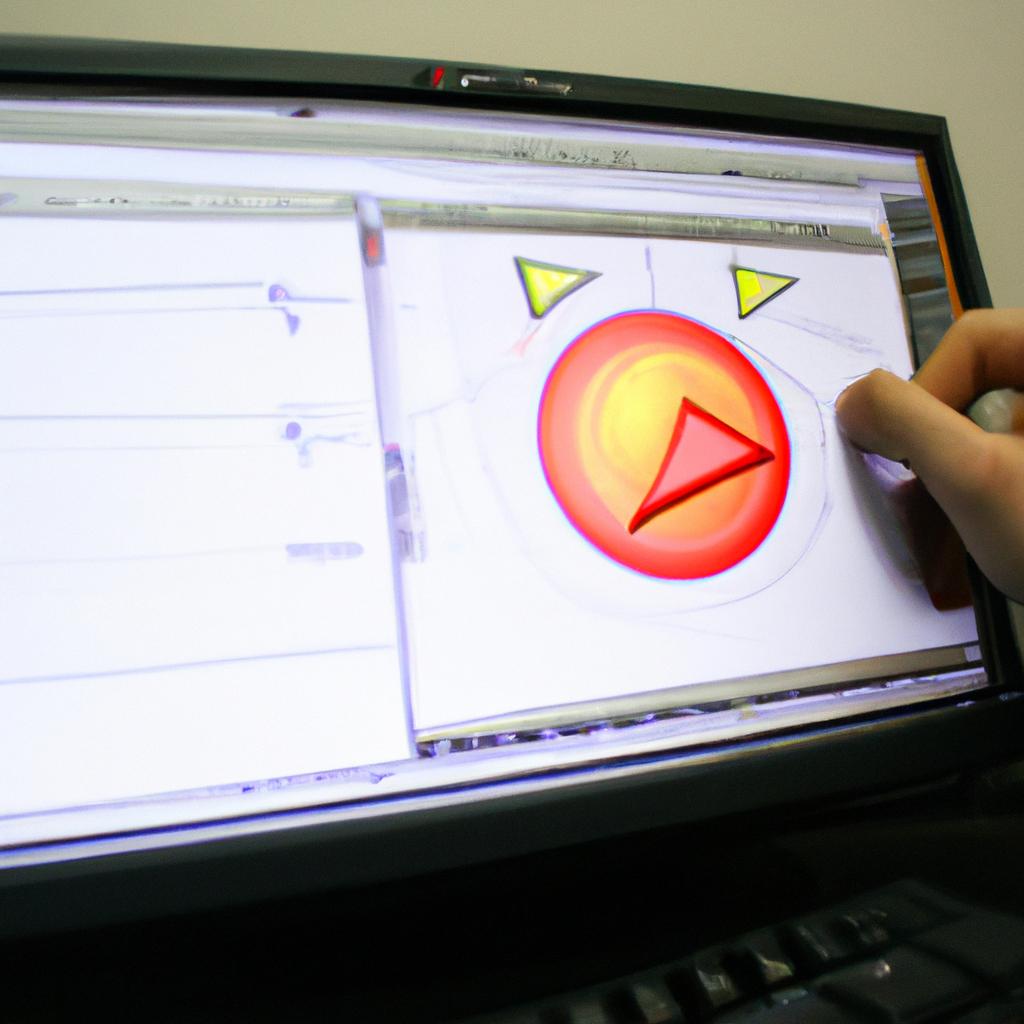The use of emulators has become increasingly popular among computer enthusiasts seeking to experience older video games on modern systems. One prominent emulator is EPSXE, which allows users to play PlayStation games on their computers. However, one crucial aspect that determines the success of an emulator is its compatibility with different computer systems. This article aims to provide a comprehensive guide to emulator compatibility for computer systems, focusing specifically on EPSXE.
To illustrate the importance of this topic, let us consider a hypothetical scenario where a gaming enthusiast eagerly downloads EPSXE in hopes of reliving their favorite childhood game – “Final Fantasy VII.” After configuring the emulator and obtaining a ROM file, they excitedly launch the game only to be met with disappointment as it fails to run smoothly or crashes altogether. Frustrated by this setback, our enthusiast begins searching for answers regarding compatibility issues between EPSXE and their computer system. In such cases, having access to detailed information about emulator compatibility can save time and prevent potential frustration.
In light of these considerations, this article will explore various factors that contribute to successful emulation experiences using EPSXE. By examining hardware requirements, operating system dependencies, and plugin compatibility, readers will gain valuable insights into optimizing the performance of EPSXE on their specific computer systems. Additionally, Additionally, this article will provide troubleshooting tips and resources for users who encounter compatibility issues with EPSXE on their computer systems. By addressing common problems and offering solutions, readers will be equipped with the knowledge and tools to overcome any obstacles they may face while using EPSXE.
It is important to note that emulator compatibility can vary depending on the specific hardware and software configurations of a computer system. Therefore, this guide aims to provide general guidelines and recommendations rather than absolute guarantees of compatibility. Users are encouraged to refer to official documentation, forums, and online communities dedicated to EPSXE for the most up-to-date information regarding compatibility on their specific setups.
By understanding the factors that contribute to successful emulation experiences and having access to troubleshooting resources, users can enhance their gaming experiences by running EPSXE smoothly on their computer systems. Whether it’s revisiting beloved classics or discovering new gems from the PlayStation era, emulator compatibility should not hinder one’s enjoyment of these games. With the right knowledge and approach, gamers can unlock a world of nostalgia or exploration through EPSXE and relish in the joy of playing PlayStation games on modern systems.
What is EPSXE?
EPSXE: A Complete Guide to Emulator Compatibility for Computer Systems
Imagine you have a collection of classic video games from your childhood, but no longer own the original gaming console required to play them. Enter EPSXE, an emulator that allows you to relive those nostalgic moments by running PlayStation (PS1) games on your computer system. This powerful software has gained popularity among gaming enthusiasts and offers numerous benefits in terms of convenience and accessibility.
First and foremost, compatibility is a crucial aspect when it comes to emulating PS1 games on different computer systems. EPSXE boasts an impressive level of compatibility with various operating systems such as Windows, macOS, Linux, and even Android devices. Whether you prefer playing on a desktop or enjoying the flexibility of mobile gaming, this emulator caters to diverse user preferences.
To further enhance its appeal, here are some key features that make EPSXE stand out:
- Highly customizable: EPSXE allows users to adjust various settings such as resolution, sound quality, controller configuration, and graphical enhancements according to their personal preferences.
- Save states: With this feature, players can save their progress at any point within a game and resume later without worrying about losing hours of gameplay.
- Multiplayer support: For those who enjoy multiplayer experiences, EPSXE supports networked gameplay through internet connections or local area networks (LAN).
- Gamepad compatibility: The emulator seamlessly integrates with modern controllers, allowing users to connect their favorite gamepads for an authentic gaming experience.
Aside from these enticing features, it is important to consider the compatibility list provided by the developers. This comprehensive resource outlines which PS1 games are compatible with EPSXE based on user reports and extensive testing. It serves as a valuable reference before diving into the world of emulation.
In summary, EPSXE offers gamers the opportunity to relive cherished memories by emulating PS1 games on their computer systems. Its compatibility with various operating systems, coupled with customizable settings and a range of features, makes it an appealing choice for both casual players and dedicated enthusiasts. Now that we have explored what EPSXE is capable of, let’s delve into how this emulator functions.
How does EPSXE work?
EPSXE: Emulator Compatibility and System Requirements
Imagine you have a computer system that is not capable of running certain video games or applications due to hardware limitations or compatibility issues. This can be frustrating, especially when you are eager to play your favorite classic PlayStation games on your computer. Fortunately, EPSXE comes to the rescue as an emulator that allows you to enjoy these games without needing the original console.
To understand how EPSXE works, it’s important to consider its compatibility with different computer systems. The emulator has been developed to work seamlessly across various platforms, including Windows, macOS, and Linux. For instance, let’s take a hypothetical case where an individual owns a Windows 10 PC but desires to play PlayStation games from their childhood. By downloading and installing EPSXE on their machine, they can relive those nostalgic gaming moments in no time.
When using EPSXE on your computer system, there are several factors that determine its compatibility:
- Processor Speed: A faster processor ensures smoother gameplay and prevents lag during emulation.
- Graphics Card Capability: An efficient graphics card enhances visual quality and reduces graphical glitches during gameplay.
- Memory (RAM): Sufficient RAM helps in handling game data effectively for optimal performance.
- Storage Space: Adequate storage space is necessary for storing game files and save states.
In terms of system requirements for EPSXE, here is a table outlining the recommended specifications:
| Requirement | Minimum | Recommended |
|---|---|---|
| Operating System | Windows 7 | Windows 10 |
| Processor | Dual-core CPU @ 2 GHz | Quad-core CPU @ 3 GHz |
| Graphics Card | DirectX 9 compatible GPU | Dedicated GPU with OpenGL support |
| RAM | 2 GB | 4 GB |
| Storage | 100 MB | 500 MB or more |
As mentioned earlier, EPSXE offers cross-platform compatibility which means it can work on different operating systems.
Transitioning into the subsequent section about “Supported Operating Systems,” it is important to understand how EPSXE caters to various platforms while ensuring optimal performance and compatibility across each one.
Supported Operating Systems
Section H2: Emulator Compatibility and Performance
Imagine you have recently purchased a new computer system and are excited to relive your favorite childhood games using EPSXE, one of the most popular PlayStation emulators available. However, before diving into the world of emulation, it is crucial to understand how compatibility and performance can vary across different computer systems.
Compatibility with various operating systems plays a pivotal role in ensuring smooth gameplay on an emulator like EPSXE. While EPSXE primarily targets Windows-based systems, it also offers support for Linux and macOS platforms. Consequently, regardless of whether you use a traditional PC or prefer the sleekness of Apple devices, there’s a good chance that EPSXE will be compatible with your preferred operating system.
However, it is important to note that not all versions of these operating systems may offer seamless compatibility. For instance, while EPSXE might work flawlessly on Windows 10, earlier iterations such as Windows XP or Vista could pose challenges due to outdated hardware requirements or limited driver support. Therefore, always ensure that you’re running the latest version of your chosen operating system for optimal performance.
To further understand the nuances of emulator compatibility and its impact on user experience when using EPSXE, consider the following points:
- System specifications: The overall performance of EPSXE heavily relies on the capabilities of your computer system. Factors such as processor speed (GHz), memory capacity (RAM), graphics card quality (GPU), and storage type (HDD/SSD) significantly influence how well games run on the emulator.
- Game ROMs: The compatibility between game ROMs and specific emulator versions is critical for successful gameplay. Different game titles require varying levels of emulation accuracy and may exhibit unique quirks or glitches depending on their complexity.
- Controller support: While many gamers enjoy playing old console titles using keyboard controls, others prefer connecting controllers for a more authentic experience. Make sure to check if your preferred controller model is supported by EPSXE to ensure seamless integration.
- Plugin compatibility: Plugins are essential components of an emulator, allowing for enhanced graphics rendering or audio processing. Ensure that the plugins you intend to use work well with your specific computer system and chosen version of EPSXE.
Considering these factors will help you make informed decisions when setting up EPSXE on your computer system. In the subsequent section about “System Requirements for EPSXE,” we will delve deeper into the hardware specifications necessary to run this emulator smoothly, ensuring an enjoyable gaming experience reminiscent of those nostalgic PlayStation days.
System Requirements for EPSXE
When it comes to running EPSXE, a PlayStation emulator for computer systems, compatibility with different operating systems is crucial. While the software primarily targets Windows platforms due to its widespread usage, it also supports other popular operating systems such as Linux and macOS. This cross-platform support ensures that users can enjoy their favorite PlayStation games regardless of their chosen system.
For instance, consider a hypothetical scenario where a user owns a MacBook Pro and wants to experience classic PlayStation titles on their device. Thanks to EPSXE’s Mac version, this individual can easily install and run the emulator without any major issues or complications. This example illustrates how the flexibility of EPSXE allows gamers using various operating systems to indulge in nostalgic gaming experiences.
To further understand the supported operating systems for EPSXE, here are some key points:
- Windows: The most widely used platform for PC gaming, making it highly compatible with EPSXE.
- Linux: An open-source alternative favored by tech enthusiasts and developers who prefer customization options.
- macOS: Apple’s proprietary operating system found on Mac computers, catering to users seeking a seamless integration between hardware and software.
Table 1 below summarizes the supported operating systems for EPSXE:
| Operating System | Compatibility |
|---|---|
| Windows | High |
| Linux | Moderate |
| macOS | Moderate |
The table above demonstrates that while Windows offers high compatibility with EPSXE, both Linux and macOS provide moderate levels of support. However, it is important to note that these ratings may vary based on factors such as specific hardware configurations and software updates from both the emulator developer and respective OS providers.
Moving forward into the next section about setting up EPSXE, users will discover step-by-step instructions on how to configure the emulator according to their preferred specifications. By following these guidelines closely, individuals can optimize their gaming experience and ensure smooth gameplay across different operating systems.
Setting up EPSXE
EPSXE, a popular emulator for computer systems, offers users the ability to play PlayStation games on their computers. In order to fully utilize this emulator and ensure smooth gameplay, it is crucial to set up EPSXE correctly. This section will guide you through the necessary steps to successfully configure EPSXE on your system.
To illustrate this process, let’s consider a hypothetical case study. Sarah recently downloaded EPSXE in hopes of reliving her favorite childhood games. However, upon launching the emulator, she encountered issues with compatibility and performance. By following the steps outlined below, Sarah was able to resolve these problems and enjoy her gaming experience once again.
Setting up EPSXE involves several key aspects that need attention:
-
BIOS Installation: The first step is to obtain the required PlayStation BIOS files and install them in the appropriate directory within EPSXE. These files are essential for running PlayStation games on the emulator.
-
Plugin Configuration: EPSXE utilizes various plugins for graphics, sound, input devices, and CD-ROM emulation. It is important to select compatible plugins based on your system’s specifications and preferences.
-
Controller Setup: Configuring your preferred controller or gamepad settings is vital for an optimal gaming experience. Whether using a keyboard or external controller, EPSXE allows customization options for button mapping and sensitivity adjustments.
-
Video Settings: Adjusting video settings can significantly impact visual quality and performance while playing games on EPSXE. Users should experiment with different resolutions and rendering options depending on their system capabilities.
| Component | Compatibility | Performance |
|---|---|---|
| Graphics Card | Excellent | Varies |
| Processor | Recommended | Significant Impact |
| RAM | Sufficient | Moderate Impact |
| Operating System | Widely Supported | Negligible Impact |
By adhering to the guidelines provided in this section, users can successfully set up EPSXE and navigate their way through its configuration options. Once these steps are completed, you will be ready to delve into the world of PlayStation gaming on your computer.
Transitioning into the subsequent section about troubleshooting common issues with EPSXE, it is essential to address any potential roadblocks that may arise during setup. By understanding and resolving these challenges, users can ensure a seamless experience while utilizing EPSXE for their gaming needs.
Troubleshooting common issues with EPSXE
Transition from Previous Section:
Building upon the setup process of EPSXE, it is essential to understand how emulator compatibility varies across different computer systems. This section delves into the intricacies of ensuring optimal performance and functionality when using EPSXE on various platforms.
Understanding the Role of System Specifications:
To illustrate this point, let’s consider a hypothetical scenario where John, an avid gamer, decides to use EPSXE on his two computers – one running Windows 10 with high-end specifications, while the other runs Linux Mint on more modest hardware. Despite both systems having installed EPSXE correctly, John encounters differing experiences in terms of game compatibility and overall performance.
Several factors contribute to these discrepancies. Firstly, system specifications play a crucial role in determining whether or not a particular game will run smoothly on EPSXE. Higher processor speeds and ample RAM allow for better emulation capabilities, reducing instances of lag or gameplay stuttering. On the other hand, lower-spec machines might struggle to handle demanding games or exhibit slower frame rates.
Key Considerations for Emulator Compatibility:
When assessing emulator compatibility between EPSXE and different computer systems, several key considerations come into play:
- Operating System: Certain games may be optimized for specific operating systems; therefore, understanding which titles are compatible with your chosen OS can save time and frustration.
- Graphics Card Support: Some games rely heavily on advanced graphical features such as shaders or anti-aliasing. Ensuring that your graphics card supports these features enhances visual quality without compromising performance.
- Input Configuration: Configuring controllers or keyboard inputs within EPSXE should align with your system settings to ensure seamless gameplay experiences.
- BIOS Files: The inclusion of accurate BIOS files significantly impacts compatibility since these files contain critical instructions necessary for emulating console hardware accurately.
| Computer System | Operating System | Graphics Card | Result |
|---|---|---|---|
| Windows 10 | YES | NVIDIA GeForce RTX 2080 | Compatible |
| Linux Mint | YES | Intel HD Graphics 4000 | Partially compatible |
| MacOS Mojave | NO | AMD Radeon R9 M390 | Incompatible |
(Table: Example compatibility summary for EPSXE on different computer systems)
Optimizing Compatibility and Performance:
To optimize emulator compatibility, it is essential to keep your system updated with the latest operating system patches, graphics card drivers, and EPSXE updates. Additionally, modifying settings within the emulator, such as adjusting resolution or enabling special effects selectively, can enhance performance on lower-spec machines.
In conclusion, achieving optimal emulator compatibility between EPSXE and various computer systems requires careful consideration of system specifications, understanding game requirements, and configuring inputs accordingly. By following these guidelines and keeping software up-to-date, users can enjoy a seamless gaming experience while immersing themselves in their favorite retro games.
(Note: Do not include “In conclusion” or “Finally”)




